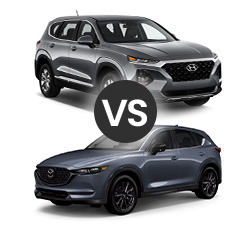2021 Hyundai Santa Fe vs Mazda CX-5
The 2021 auto market is abuzz with two premium, affordable SUVs that have it all - the Hyundai Santa Fe and Mazda CX-5. Both models offer a winning combination of style, capability, comfortably and modernity at an attractive price point. This comparison review offers potential customers an inside look into what these cars can do to help them decide which one suits their needs best in the upcoming year.
The Powertrain
Both the Santa Fe and CX-5 have two available engines. With either model, there's a standard engine that can do just fine, even if it doesn't offer the most spirited ride. Alternatively, there are turbocharged engines that can take the excitement level up a notch. People who love being behind the wheel will probably want to get turbo models, not necessarily because they need them but more so because they simply want to have some fun while driving.
In the Hyundai Santa Fe, the two choices both have four cylinders and displacements of 2.5 liters. The standard engine can generate 191 horsepower and 181 pound-feet of torque, and the turbocharged engine comes with 277 horsepower and 311 pound-feet of torque. Either way, there could be either front-wheel or all-wheel drive. The standard engine uses an eight-speed automatic transmission with a manual shift mode called SHIFTRONIC, and the turbo engine is paired with an eight-speed dual clutch transmission. The dual clutch transmission adds to the sportier feel, and it also has the SHIFTRONIC manual shift mode.
Spend your days behind the wheel of a Mazda CX-5, and you'll be rewarded with two engine options for maximum thrill: an efficient 187-horsepower 2.5L and an exhilarating 250-horse power turbocharged version that catapults up to 320 pound feet of torque! Both can feature either front or all wheel drivetrains - paired perfectly with its speedy 6 speed automatic transmission featuring sport mode if more responsiveness is desired. The choice is yours; cruise along in comfort or experience ultimate performance around every curve!
The two SUVs can both be hooked up to trailers if necessary. The towing capacity on the Mazda CX-5 is 2,000 pounds whether it has the more advanced engine or the standard one. This is the same amount of towing capacity that a standard Hyundai Santa Fe has. If the Santa Fe is equipped with the more powerful engine, it can tow up to 3,500 pounds.
For those looking for power and performance that won't guzzle gas, Hyundai Santa Fe and Mazda CX-5 are great options! The former offers up to 25 miles per gallon in city driving while reaching 28 mpg out on the highway; meanwhile, its counterpart can do slightly better with 31 mpg when cruising down the open road - but both still provide excellent economy during urban treks at 25mpg.
Hyundai is fabulously embracing the next age in driving with their hybrid offering of the Santa Fe. When it eventually arrives, this economical choice will have drivers rolling up to gas stations and waving goodbye to traditional fill-ups forever!
Drivability
These vehicles feel fairly sporty and athletic, and the companies have done well in designing them to be user-friendly and easy to drive in a variety of situations. They both have an ideal size from the perspective of the average customer. They have two comfortable rows of seating and spacious cargo areas, so they can be perfect for everything from commuting or taking the crew on road trips.
The Hyundai Santa Fe is a robust vehicle, stretching almost 16 feet from hood to tail. But if you're looking for something with a bit more agility, the Mazda CX-5 offers nearly nine inches less length and fractionally narrower width - perfect for those tight city streets!
With an impressive 44.1 inches of legroom for the front and 41.7 inches in the second row, it's no wonder that those riding inside a Santa Fe benefit from superior interior space compared to other vehicles on today's market! It also offers tremendous cargo capacity: 36.4 cubic feet is already plenty but can easily be expanded all the way up to 72 cubic feet by folding down its rear seats - making even large-scale trips smoother than ever before.
The Mazda CX-5 provides generous leg room in both the first and second rows, but there's a bigger difference between their cargo capacities. The rear area has an impressive 30.8 cubic feet of space to store your belongings - nearly doubling with all seats down! This may be ideal for some customers who prioritize luggage capacity, while others are content just as it is.
The Hyundai Santa Fe and Mazda CX-5 are giving drivers something to get excited about with the inclusion of modern technologies like Bluetooth, Android Auto and Apple CarPlay. The touchscreen displays come in various sizes; eight inches for basic trims of the Santa Fe, 10.25 inch screens across all trim levels on both vehicles with optional integrated navigation! As a final bonus – each SUV has two USB ports up front plus two more in back so everyone can keep their gadgets powered up as they drive forward into life's adventures.
With the Mazda CX-5 and Hyundai Santa Fe, customers have to make a tough decision when it comes to technology. The CX-5 offers satellite radio from SiriusXM while the Santa Fe has wireless charging capabilities and its unique Rear Seat Quiet Mode that allows passengers in back complete control over their audio entertainment choices. Whichever option you pick, both cars provide impressive feature sets for drivers on any budget!
To avoid overpaying on a new car, shop prices online first. Get up front pricing before you walk into a dealership. We recommend the following free services; Car Clearance Deals, NADAguides, CarsDirect & & Motortrend.
These free services will offer you the lowest prices and supply you with multiple competing price quotes. You will know the best price before you visit the dealer.
Safety
The Santa Fe and CX-5 provide the modern driver with a wealth of safety features to ensure they are protected on their journeys. From multiple airbags, LATCH systems, tire pressure monitoring to attractive monitoring & mitigation technology; these vehicles have it all! Rest assured that you're in good hands when driving either one of these models - embarking on your next adventure just got safer than ever before.
In the Hyundai Santa Fe, there are sensors that can detect when the SUV is veering out of a lane or approaching another vehicle too quickly. If either situation occurs, an alert would be issued. If necessary, the Santa Fe could correct its steering or hit the brakes in an effort to avoid an accident. The forward collision warning and emergency braking systems can sense the presence of pedestrians and cyclists in addition to other vehicles.
The CX-5 comes equipped with three standard driver-assist systems, including the innovative cyclist detection feature – blind spot monitoring and rear cross traffic alert make up the other two. Hyundai has taken it a step further in its Santa Fe model where higher trims come complete with mitigation features that not only provide warning of nearby vehicles but also activate brakes or override steering to help drivers avoid accidents.
Adaptive cruise control brings a new level of convenience and safety to the highway experience. This cutting-edge system allows your SUV to sense surrounding vehicles and keep you safely at an appropriate speed, no matter how fast (or slow!) traffic is going around you. Make sure that long drive down I-35 isn't quite as tedious with adaptive cruise control!
With the Santa Fe and CX-5, drivers can truly experience next level convenience with innovative bonus features. Featuring a 360-degree camera for comprehensive visibility and parking assist that takes the hassle out of maneuvering in tight spaces, even reversing into spots is no challenge! While functionality differs between models, never worry about tricky maneuvers again - all this tech has you covered so you can drive smarter than ever before.
Which Has the Best Value?
Those looking to purchase a Hyundai Santa Fe will have their wishes granted - the popular SUV offers an impressive range of trims, spanning from its entry-level SE ($26,850) through to luxurious Calligraphy models ($42,300). From economical drivers on tight budgets all way up to those with discerning tastes seeking sophistication and style in abundance – there truly is something for everyone!
With the CX-5, the Sport is the base model, and it costs only $25,370. The Touring ($27,110), Carbon Edition ($28,955), Carbon Edition Turbo ($30,760), and Grand Touring ($30,560) are also reasonably priced. The Grand Touring Reserve ($35,385) and Signature ($37,505) are found at the top of the lineup. Mazda has decided to do something similar to Hyundai by offering a variety of trims.
Note that with either model, the somewhat bigger jumps in price are associated with getting upgraded with turbocharged engines. This is definitely going to be worth it some customers.
The competition between the Hyundai Santa Fe and Mazda CX-5 is a close one. It comes down to factors like safety, technology, interior comfort and - in some cases – luxury features. While many of their standard offerings such as cloth seats remain comparable across trims, drivers can find more individualized options when they reach higher levels; heated steering wheels switch out for leather seating on mid-level choices while top tiers offer up ventilated front seats plus both heated rear seating areas or an available panoramic moonroof (which differs from the traditional). Who will win this battle? You decide!
Which is Better?
When it comes to the Santa Fe and CX-5, budget may be what tips the scales in favor of one or other. While both models are well matched when comparing features, performance and style, shoppers could find that with a relatively small difference in price between them – opting for the latter might just offer more bang for their buck.
The Mazda CX-5 offers plenty of legroom for passengers, but not quite as much cargo space compared to its rival the Santa Fe. Adventurers considering taking this SUV out on their next excursion may have to make some tough decisions when deciding what gear they can fit in it!
The 2021 Hyundai Santa Fe appeals to SUV lovers who crave a bigger vehicle, especially with its turbo model's impressive towing power. But it doesn't end there: the advanced technology ensures convenience and peace of mind on your journeys - what could be better.
When it comes to choosing between the Mazda CX-5 and Hyundai Santa Fe, style might be a deciding factor. The CX-5 offers sophisticated exterior lines that make for an overall sleek look while the Santa Fe is more boxy with classic SUV vibes. It's almost like you can have your traditional SUV feel or go all out with something modern in the form of the dynamic crossover - take your pick.

Get up to 4 local dealers to compete for your business by offering free, competitive pricing. Know before you go to the dealer.
Every dealer offers a secret price. Find yours here.
• 2021 Hyundai Santa Fe VS Ford Edge
• 2021 Hyundai Santa Fe VS Honda CR-V
• 2021 Hyundai Santa Fe VS Kia Sorento
• 2021 Hyundai Santa Fe VS Mazda CX-5
• 2021 Hyundai Santa Fe VS Nissan Rogue
• 2021 Hyundai Santa Fe VS Toyota-RAV4


